https://circuitmess.com/pages/butter-bot-teaser



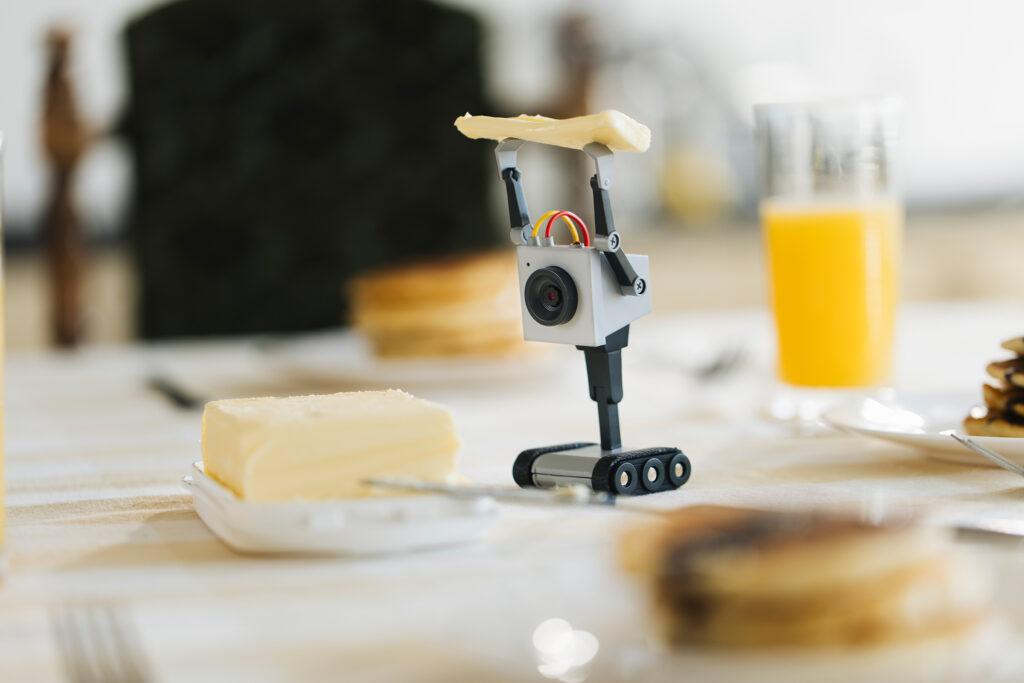
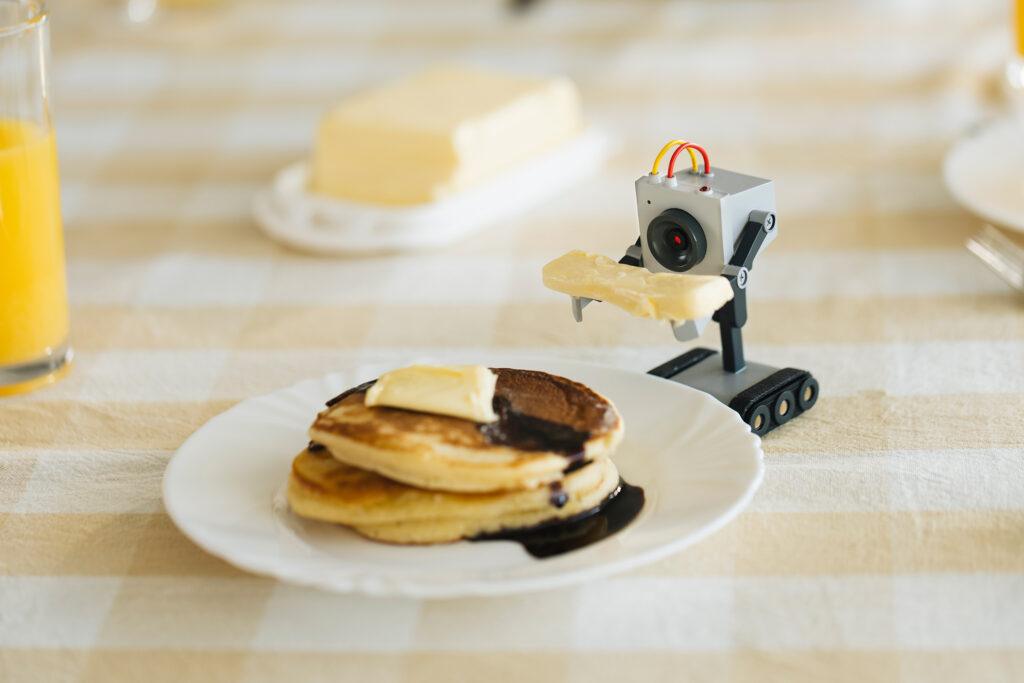

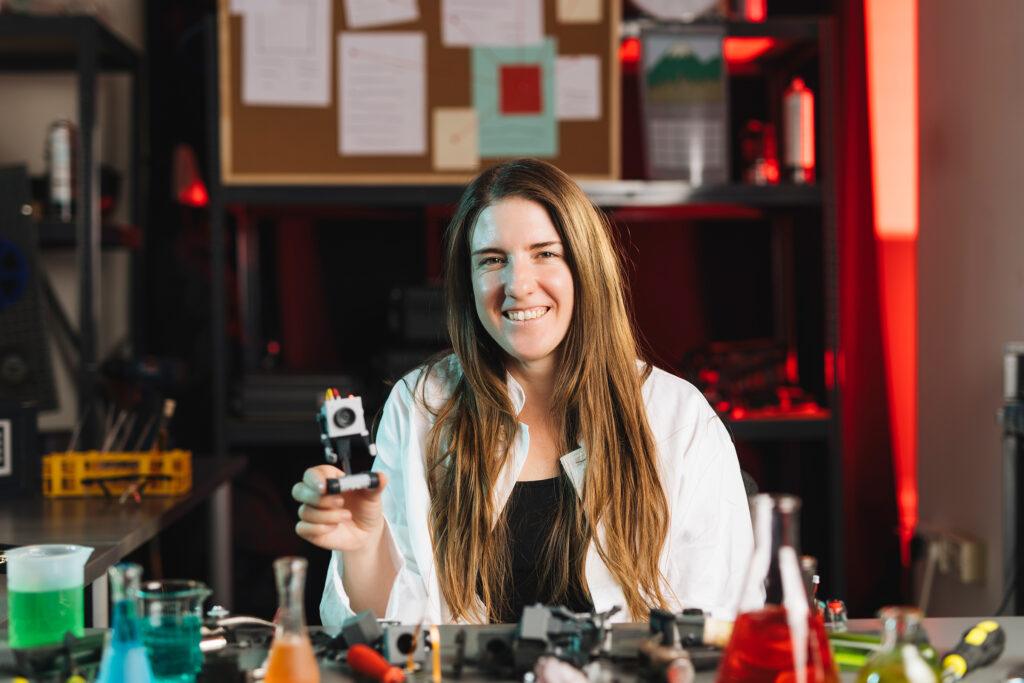

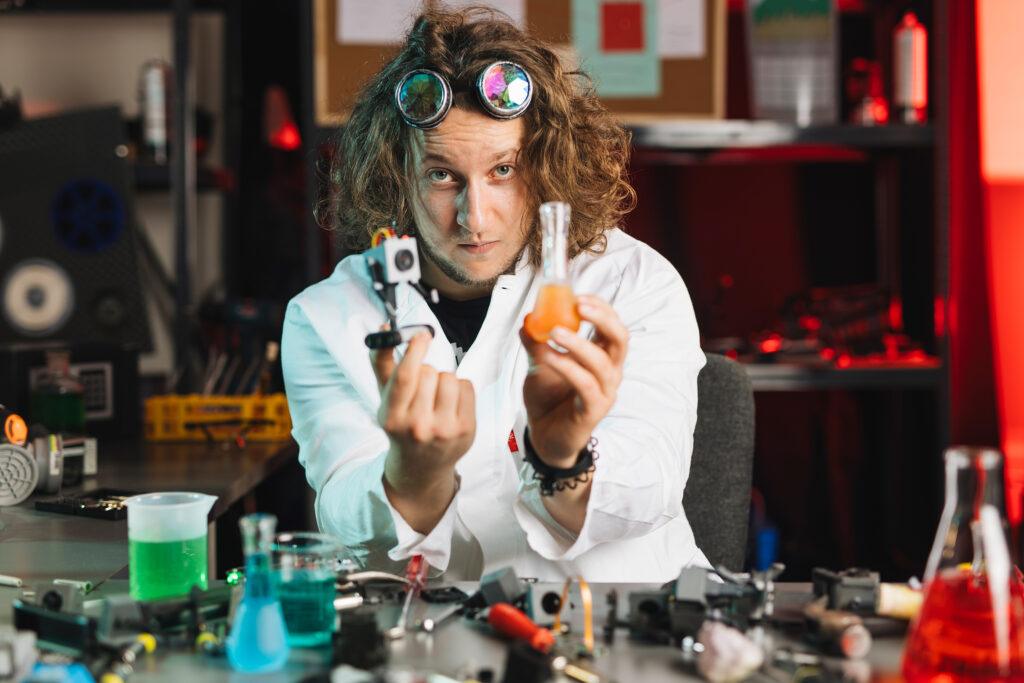
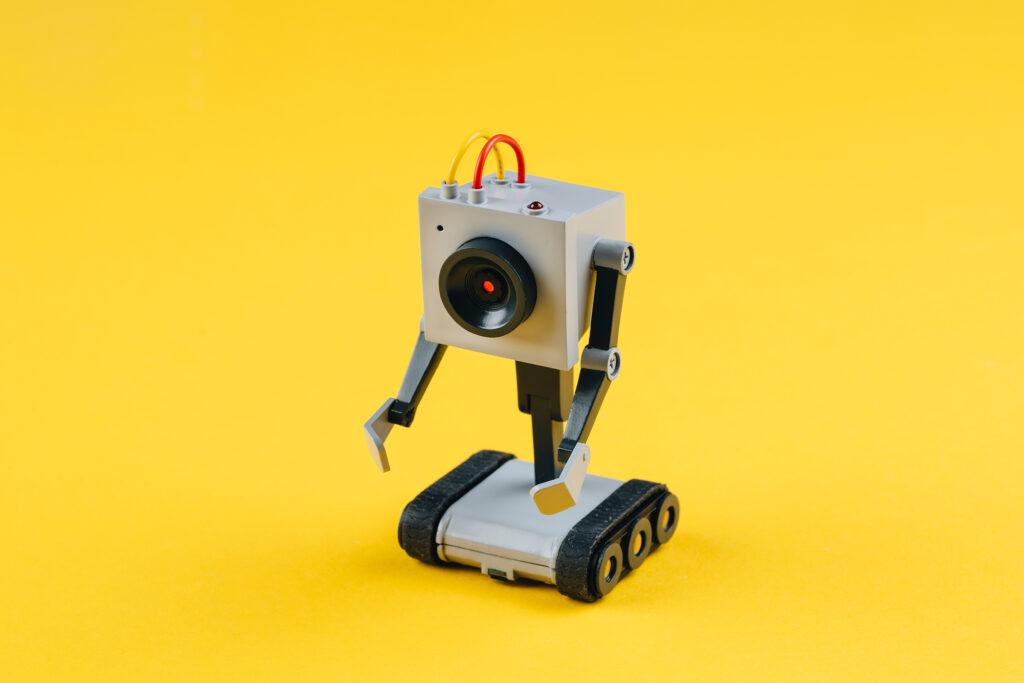
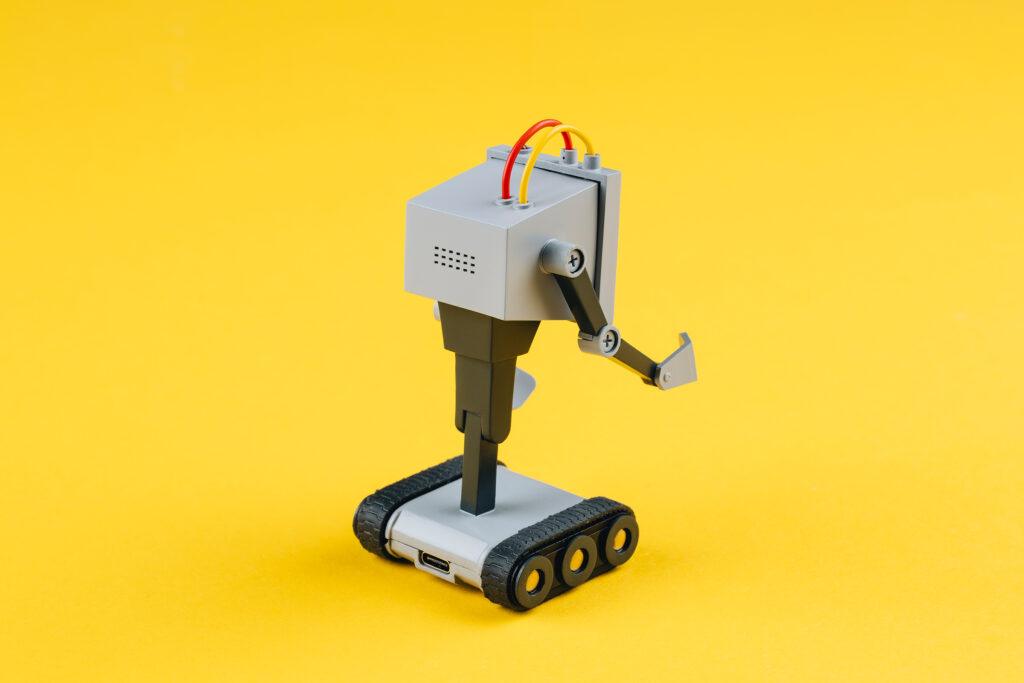
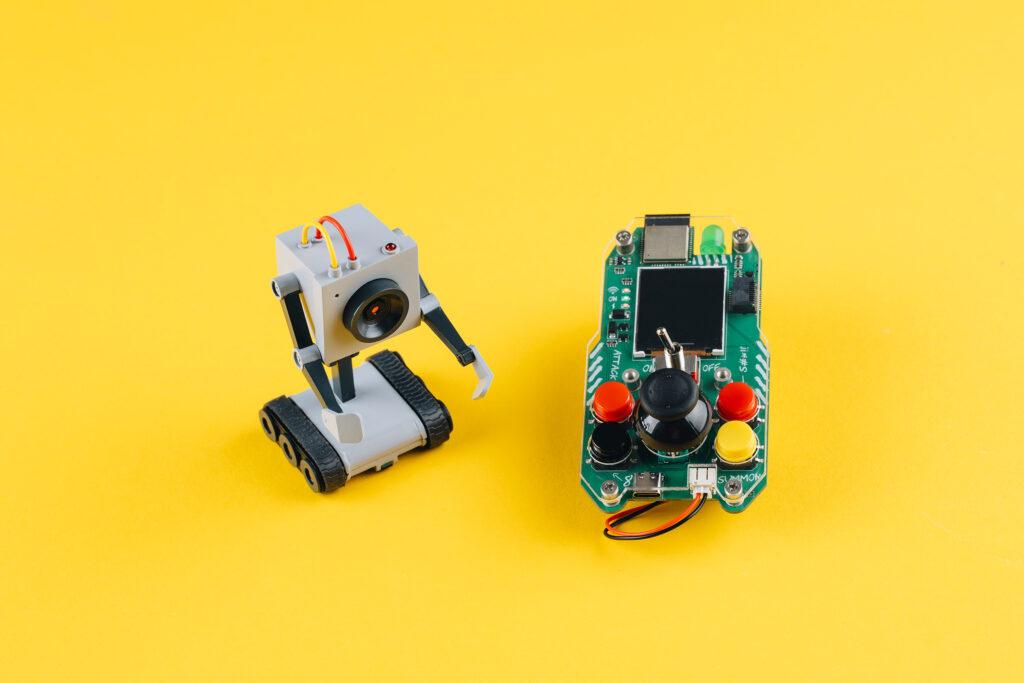
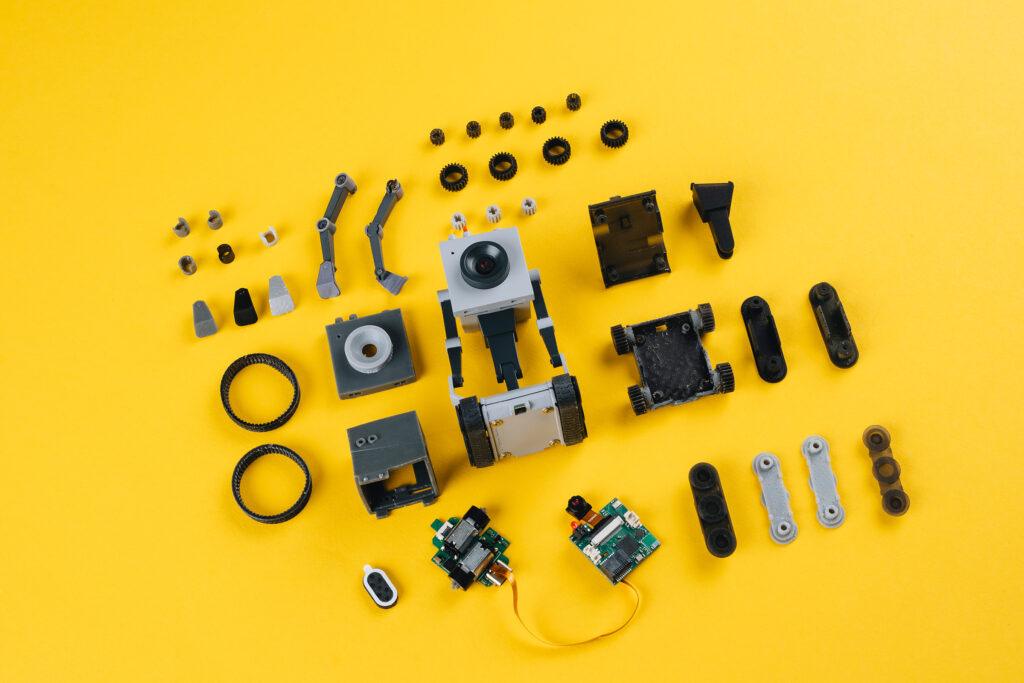

Montreal/Berlin, 18. September 2024 – Vention, das Unternehmen hinter der cloud-basierten Manufacturing Automation Platform (MAP), stellt auf seinem heutigen Demo Day in Berlin eine neue KI-Anwendung vor. MachineMotion AI ist der erste KI fähige Automatisierungscontroller mit beschleunigter Computertechnologie von NVIDIA.
Als Herzstück des Hardware- und Software-Ökosystems von Vention schließt MachineMotion AI die Lücke zwischen herkömmlichen speicherprogrammierbaren Steuerungen (SPS) und modernen Roboterprogrammierumgebungen. Der Controller der dritten Generation wurde entwickelt, um die Konzeption und Bereitstellung von Roboteranwendungen für produzierende Unternehmen jeder Größe erheblich zu vereinfachen.

MachineMotion AI basiert auf der NVIDIA Jetson-Plattform für Edge-KI und -Robotik. Der Controller entwickelt KI-fähige Roboter mit NVIDIA GPU-beschleunigter Pfadplanung weiter und bietet die Möglichkeit, 2D-/3D-Wahrnehmungsmodelle auszuführen, die in synthetischen und physischen Umgebungen trainiert wurden.
MachineMotion AI ist mit führenden Robotermarken (z.B. Universal Robots, FANUC und ABB) kompatibel und lässt sich per Plug-and-Play mit Hunderten von Bewegungsgeräten und Sensoren verbinden – von Förderbändern und Aktuatoren bis hin zu Sicherheitsgeräten, Computer-Vision-Systemen, Telepräsenzkameras und mehr.
„Wir sind auf dem Weg, die industrielle Automatisierung zu demokratisieren und bauen dabei das umfassendste Unternehmen für industrielle Automatisierung und Robotik auf. Die heutigen Ankündigungen festigen Ventions Position als intuitivste Plattform für Automatisierung und Robotik und zeigen gleichzeitig die fortschrittlichen Funktionen, die Experten in der Branche benötigen“, sagt Etienne Lacroix, Gründer und CEO von Vention.
Weitere Informationen zu der Zusammenarbeit mit NVIDIA finden Sie hier. Demo Day in Berlin (18.9.)
Der diesjährige europäische Demo Day findet am 18.9. ab 14 Uhr in der Vention Europazentrale in Berlin statt. Etienne Lacroix, Gründer und CEO von Vention, wird vor Ort sein und für Pressegespräch zur Verfügung stehen. Mehr Informationen zum Event in Berlin finden Sie hier.
Über Vention
Vention hilft Unternehmen, ihre Produktionsbereiche durch eine demokratisierte Benutzererfahrung in nur wenigen Tagen zu automatisieren. Mit der digitalen Fertigungsautomatisierungsplattform MAP von Vention können Kunden automatisierte Geräte direkt über ihren Webbrowser entwerfen, bestellen und bereitstellen. Vention hat seinen Hauptsitz in Montreal und Niederlassungen in Berlin und Boston. Die über 300 Mitarbeiter betreuen mehr als 4.000 Kunden auf fünf Kontinenten und in 25 Fertigungsindustrien.
MangDang’s Kickstarter project „MD Robot Kit: Unlock your AI Robot Engineering Dream Job“ aims to promote the creativity and technical know-how of robotics enthusiasts. It offers two main robots, each addressing different needs and interests.
The first robot, the Mini Pupper, is available in several versions, including Mini Pupper 1, Mini Pupper 2, and the 2G and 2GA models. This robot is a low-cost, personal quadruped kit that comes with open-source software. The Mini Pupper supports multimodal generative AI platforms such as OpenAI’s ChatGPT, Google’s Gemini, and AWS’s Claude. It is also compatible with ROS1 and ROS2, which expands its capabilities in the areas of SLAM (Simultaneous Localization and Mapping) and navigation. The integration of OpenCV allows the robot to perform deep learning with cameras. Thanks to the use of Raspberry Pi and Arduino, the Mini Pupper offers high adaptability and expandability, making it ideal for developers who want to realize their own projects.

The second robot presented is the Turtle Robot, which will be available soon. This robot is specifically aimed at schools, homeschooling families, and robot enthusiasts. While detailed specifications have not yet been fully released, it is clear that the Turtle Robot also aims to support learning and creativity in the field of robotics.
The campaign itself has set a funding goal of 9000€ and has clearly exceeded it with a sum of just under 19000€, which corresponds to over 200% of the original goal. The campaign runs from September 5, 2024 to October 5, 2024 and has attracted 80 supporters so far. A standout feature of the MD Robot Kits is their open-source nature, which allows users to assemble the robots in less than an hour. This makes them particularly accessible to a wide range of audiences, ranging from educational institutions to DIY enthusiasts. The project is designed not only to impart technical knowledge, but also to promote the joy of creating and customizing robots.

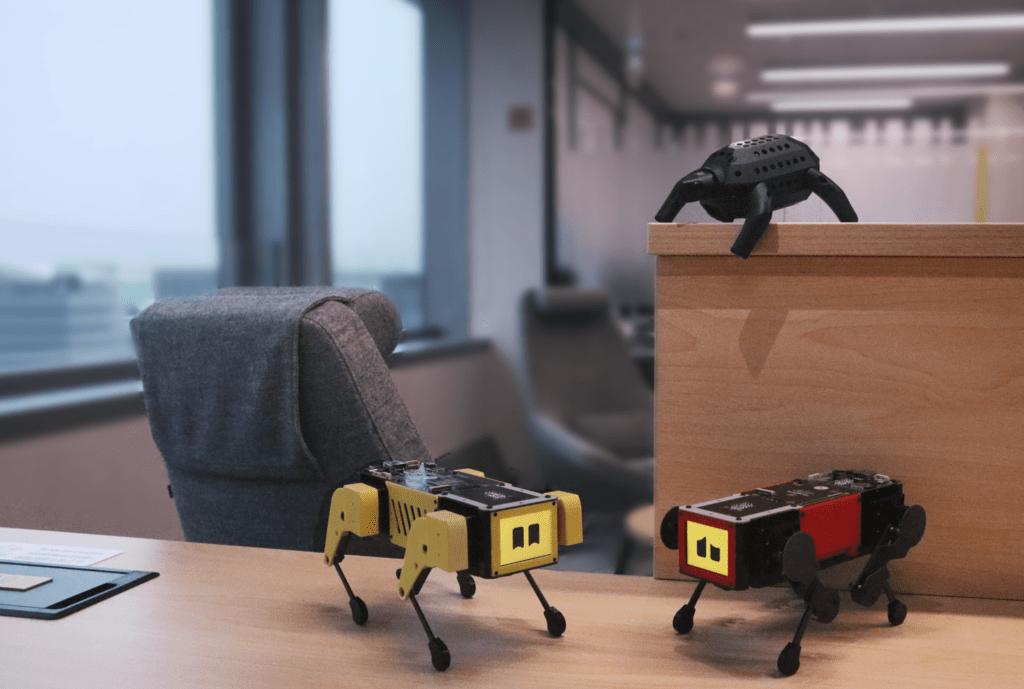
2. Turtle Robot:
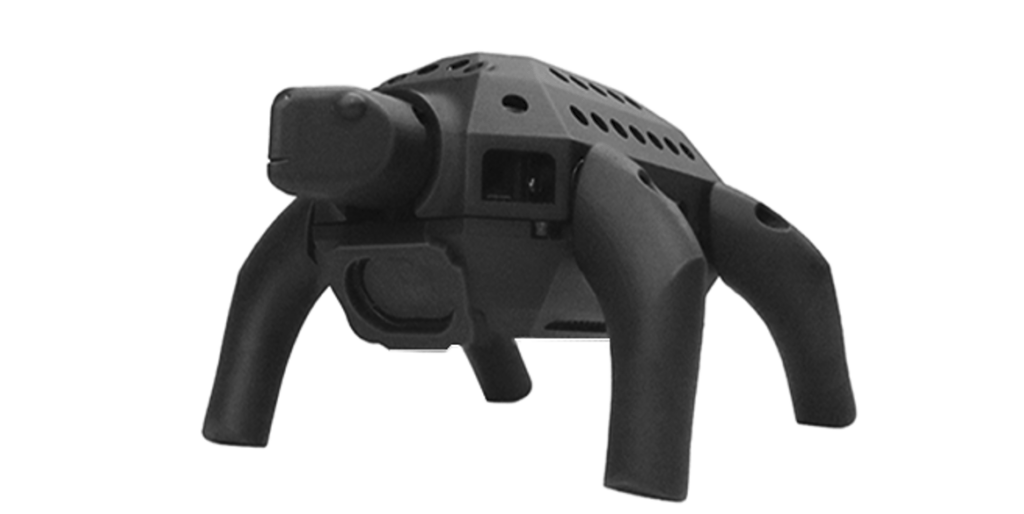

Guess what? There’s a new robot in town: Argo, the AI Smart Companion Robot for your home! „How is it possible that in 2024 we still don’t have personal robots in our homes?“
This very question sparked the creation of Argo. And who better to tackle this challenge than three innovators who have built driverless cars, drones, rockets, and space robotic arms? Their vision: to create the smart personal home robot we’ve been waiting for!
Argo excels in three main areas:
● INTELLIGENCE: ChatGPT-level conversational abilities, smart home integration (domotics) and autonomous navigation to move and follow you around your home.
● SECURITY: 24/7 video surveillance, autonomous patrolling to check every room, motion detection for intruders, and even gas leak monitoring.
● ENTERTAINMENT: From playing your favorite music to autonomously delivering drinks, Argo makes everyday life more enjoyable, with fun features like the morning alarm or the ed-tech games for your kids.
But that’s just the start. To explore all of Argo’s features, visit their website: argorobot.it.

The intuition behind Argo is that today we still have basic vocal assistants, static boxes used just to set timers, play music. In some years, we will have humanoid robots doing laundry and cooking for us. Will we switch overnight from Alexa to fully humanoid robots? Probably not. Argo is that essential step in between, and it will keep evolving day by day.
So Argo isn’t just „Alexa on wheels.“ With its mobility, interactive animations and true conversational AI, Argo delivers an entirely different user experience: one that feels more alive and engaging than simply talking to a static device.
As the famous roboticist Tomotaka Takahashi once said: „Having people talk to a brick doesn’t work, which is why Siri hasn’t succeeded.“
So Argo is an interactive companion, your AI chatty buddy and your infinite source of knowledge!
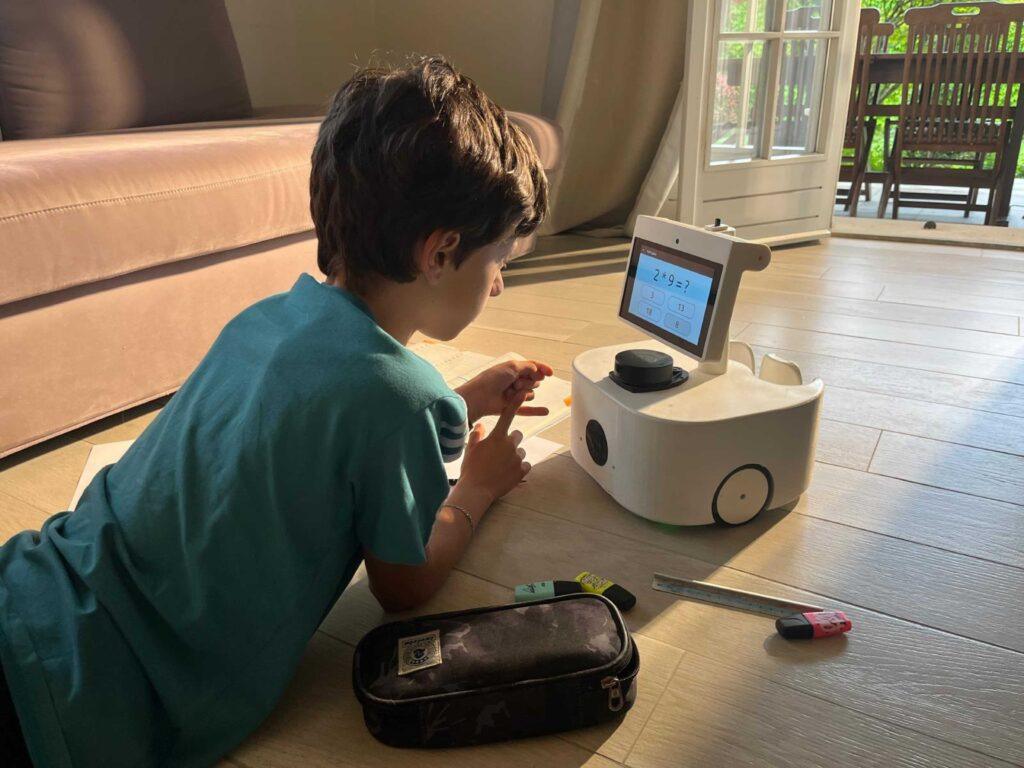
Sure, we’ve seen other unfortunate attempts in home robots before, like Kuri or Jibo, which were true pioneers. However, the technology back then wasn’t quite there. AI, LLMs and autonomous navigation systems were still in their infancy. Today, we have the tools to push the boundaries even further and at a fraction of the cost.
When you compare Argo to other robots on the market like Vector or Loona, while impressive, they tend to lean more toward toy-like design and functionality. And then there’s Amazon Astro, a high-tech marvel, but at $1,600 its price tag doesn’t align with the value it offers. Argo strikes the perfect balance: it’s more sophisticated, less of a toy and significantly more affordable, targeting a $499 price point.
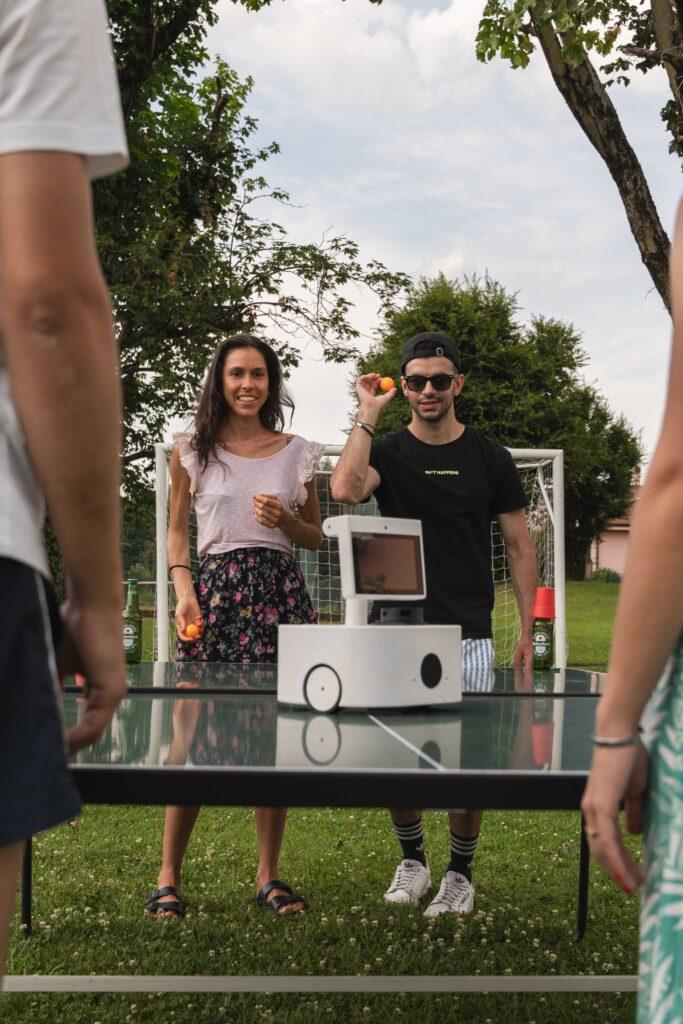
We’re seeing tech giants like Amazon and Apple (project J595) getting serious about this space, and it’s clear that smarter home robots are coming. Argo is here to be part of that revolution!
Do you want to share your ideas about home robots? Fill this quick survey to help Argo guys to craft the best home robot for you: https://forms.gle/MmNLc15wH5invino9
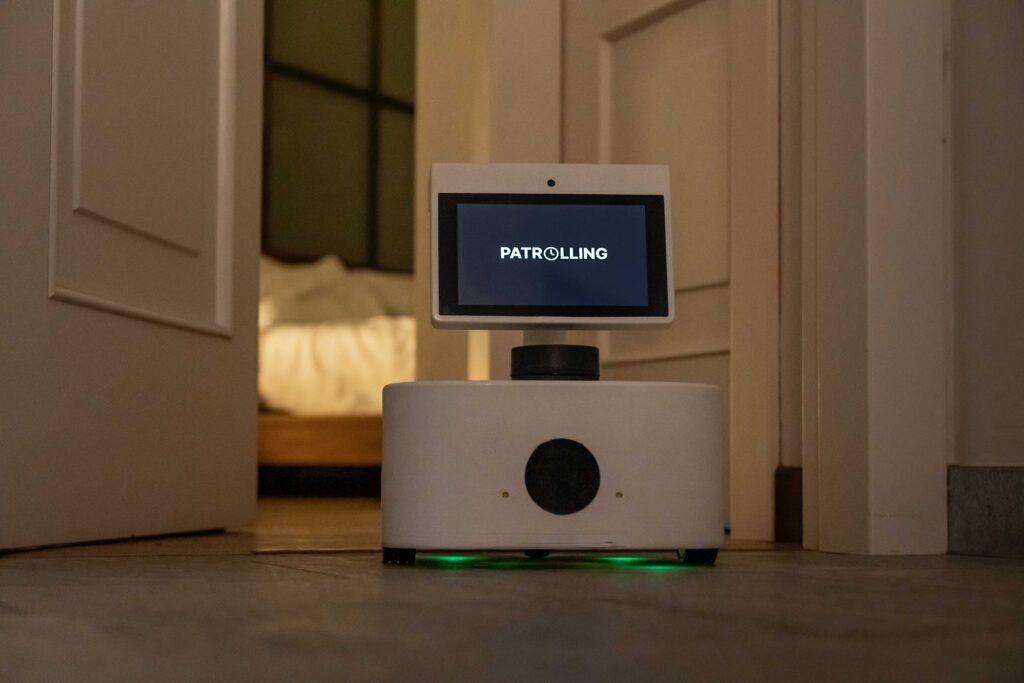
Wie Sie Kosten senken und die Vorteile der Automationsklassiker Pick & Place, Prüfen und Dosieren am besten für sich nutzen
Autor: Alexander Mühlens, Geschäftsbereichsleiter Low Cost Automation bei der igus GmbHAus der Industrie sind Roboter schon lange nicht mehr wegzudenken – ob als Maschinenbestücker, Qualitätsprüfer oder Montagehelfer. Doch viele kleinere und mittelständischen Unternehmen (KMU) drohen ins Hintertreffen zu geraten. Denn oft wissen Sie garnicht, wo sie anfangen sollen. Welche Anwendungen lassen sich überhaupt automatisieren? Und häufig scheinen die Investitionskosten zu hoch und die Integration und Bedienung zu komplex.
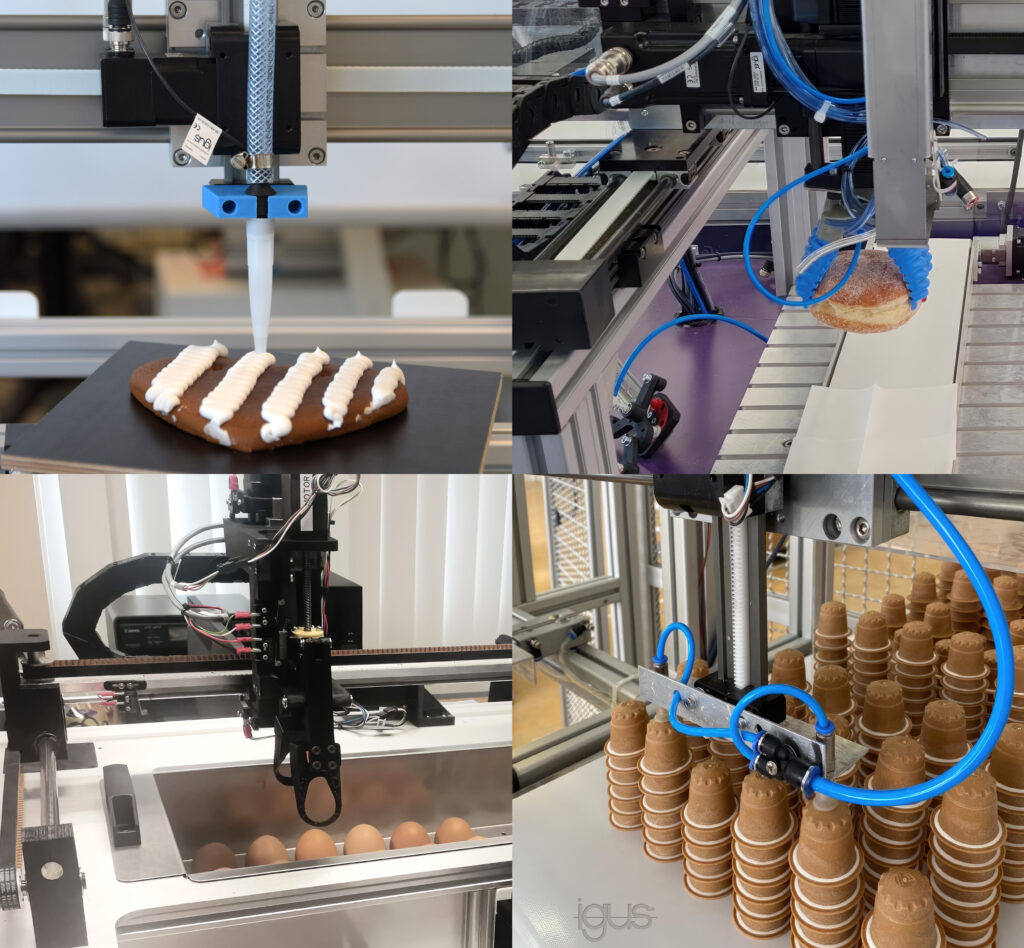
Picken, dosieren, schleifen oder prüfen: Es gibt eine Vielzahl an monotonen, repetitiven und anstrengenden Arbeiten, die sich einfach automatisieren lassen. Doch sich nur einen Roboter anzuschaffen, führt am Ende leider zu keiner Lösung. Am Ende muss das gesamte System aus Roboter und Komponenten wie Vision-Systeme, Greifer und Sensoren funktionieren. Doch insbesondere KMU wissen häufig nicht, wo sie nach einer Lösung suchen sollen und wie die passende Lösung überhaupt aussieht. Außerdem ist es wichtig, nicht zu komplex anzufangen. Der herstellerneutraler Robotik-Marktplatz RBTX hilft Automatisierungswilligen dabei, die einfachste und kostengünstigste, funktionierende Lösung zu finden.
Über 400 Komplettlösungen aus der Praxis
Das Besondere: Interessierte finden auf dem Marktplatz nicht nur Roboter und Einzelkomponenten, sondern Einblick wie es andere machen. Als Inspirationsquelle zum sofortigen Nachmachen finden sich online über 400 sofort adaptierbare Automatisierungsprojekte aus der Praxis. Von der automatisierten Regenwurmfarm über einen Berliner-Picker bis hin zum Agrarroboter, der Unkraut erkennt und vernichtet. Mehrere tausend KMU aus aller Welt haben auf RBTX.com bereits ohne konstruktionstechnische Vorkenntnisse Automationslösungen realisiert. 95 Prozent dieser Komplettlösungen sind für unter 12.000 Euro erhältlich. Die Low-Cost-Lösungen amortisieren sich nachweislich bereits ab 3-12 Monaten. Zu den Hauptanwendungsbereichen zählen unter anderem Pick & Place-Aufgaben, die Qualitätsprüfung sowie Klebe- und Dosieranwendungen.
Effizientes Handling von Produkten mit Pick & Place-Robotern
Ein Pick & Place-Roboter befördert ein Objekt zuverlässig von A nach B. Häufig handelt es sich dabei um wiederholende und zeitfressende Tätigkeiten, die viel Optimierungspotenzial innerhalb einer Produktion bieten. Ob bei der Maschinenbestückung, Palettierung, Sortierung oder Vormontage. Die Vorteile von Low Cost-Roboterlösungen haben einen Automatisierungstrend in Branchen wie Landwirtschaft, Lebensmittelindustrie, Medizintechnik bis hin zum Handwerk ausgelöst. Pick & Place-Systeme finden sich vor allem zunehmend in alltäglichen Endkunden-Anwendungen, zum Beispiel in Verkaufsautomaten.
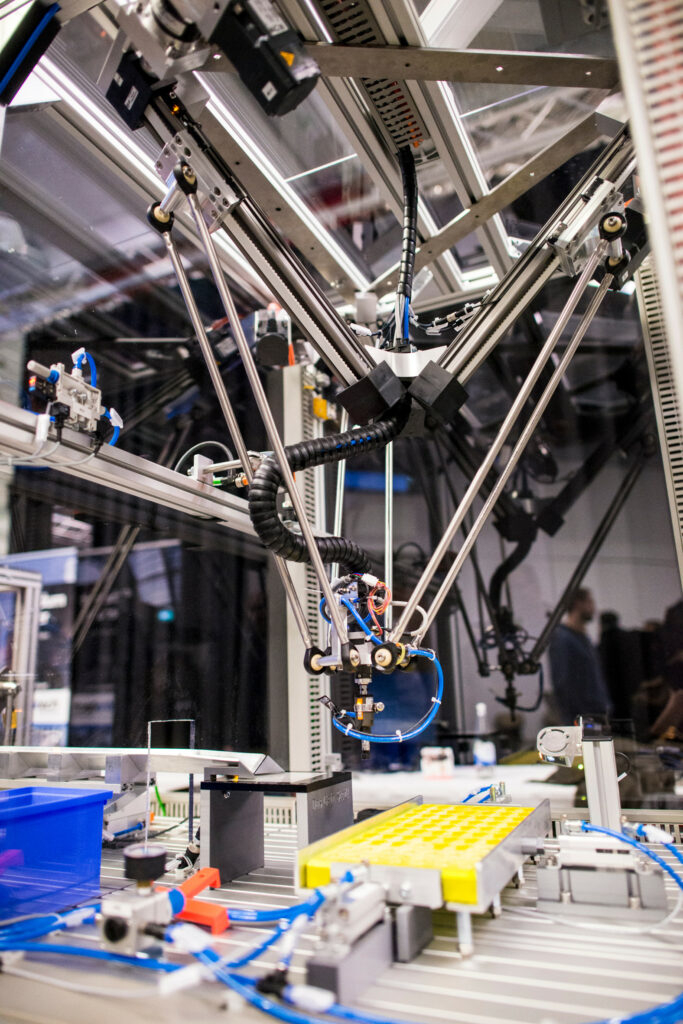
Verschiedene Robotertypen wie Gelenkarm-, Delta- oder Portalroboter können die unterschiedlichsten Anwendungsszenarios realisieren. So kommen Portalroboter zum Beispiel für das Greifen von Medikamenten zum Einsatz, um sie zur Ausgabe zu befördern, während ein SCARA Roboter als „Labor-Assistent“ das sichere Aufnehmen und Ablegen von Reagenzgläsern übernimmt – und das bereits für 7.820 Euro. Der Vorteil der Roboter-Systeme: Sie nehmen Bauteile präzise und mit konstanter Qualität auf und setzen sie am gewünschten Ablageort ab. Die Vorgänge sind exakt wiederholbar.
Automatisierte Qualitätsprüfung für mehr Präzision und Planbarkeit
Mit einer automatisierten Qualitätskontrolle lassen sich repetitive Prüfvorgänge effizient und präzise durchführen. Die Einsatzszenarien von Prüfrobotern sind so unterschiedlich und individuell wie die zu automatisierenden Arbeitsvorgänge. Ob Oberflächenprüfung, Maßprüfung oder Funktionsprüfung – Prüfprozesse und -merkmale unterscheiden sich in der Praxis stark. Mithilfe von RBTX wurde beispielsweise ein Robotersystem für das automatisierte Be- und Entladen einer Prüfstation für Leiterplatinen konfiguriert.

Ebenso ein Flächenportal, das mithilfe einer Kamera einzelne Uhren ansteuert, um visuell zu prüfen, ob sich Minuten- und Sekundenzeiger bewegen. Ein Roboterarm kommt unter anderem auch bei der End-of-Line-Prüfung von Ladegeräten für Elektrofahrzeuge zum Einsatz. Prüfprozesse lassen sich durch den Einsatz von Robotern effizient verschlanken und besser planen. Darüber hinaus arbeiten Roboter rund um die Uhr ohne Qualitätseinbußen. Es werden identische Vorgänge und eine präzise, gleichbleibende Messung des Prüfmerkmals sichergestellt.
Sicher kleben und dosieren – ohne Materialverschwendung
Neben Prüf- und Pick & Place-Aufgaben kann auch das Auftragen von Klebe-, Versiegelungs-, Lackiermitteln und Isolierschäumen effizient automatisiert werden. Meistens geht es darum Materialverschwendung zu vermeiden und präziser zu kleben bzw. zu dispensieren. Und dafür benötigt man keinen Roboter mit Investitionskosten im 6-stelligen Bereich. Mit Low Cost-Robotern kann fast alles verklebt werden. Sie erreichen eine Präzision von ca. 0,5 mm. Ein weiterer Grund ist die Arbeitsplatzsicherheit. Denn der Roboter kann problemlos mit Chemikalien in Berührung kommen und unterstützt bei unergonomischen Arbeiten. Vor allem Klebeprozesse an kleinen Werkstücken, erfordern ein hohes Maß an Konzentration und Präzision. Dabei ist es häufig wichtig, dass der Kleber das Bauteil exakt abdichtet. Dort liegt die Automation durch Roboter nah. Mithilfe von RBTX konnte zum Beispiel ein Kunde durch den Einsatz eines automatischen Dosierroboters die Geschwindigkeit beim Auftragen von Dichtungsmasse auf ein Metallteil, einem wichtigen Arbeitsschritt in seiner Produktion, vervierfachen. Die einfache Handhabung der Maschine ermöglicht es selbst ungeschulten Mitarbeitern, den Roboter sofort zu nutzen.
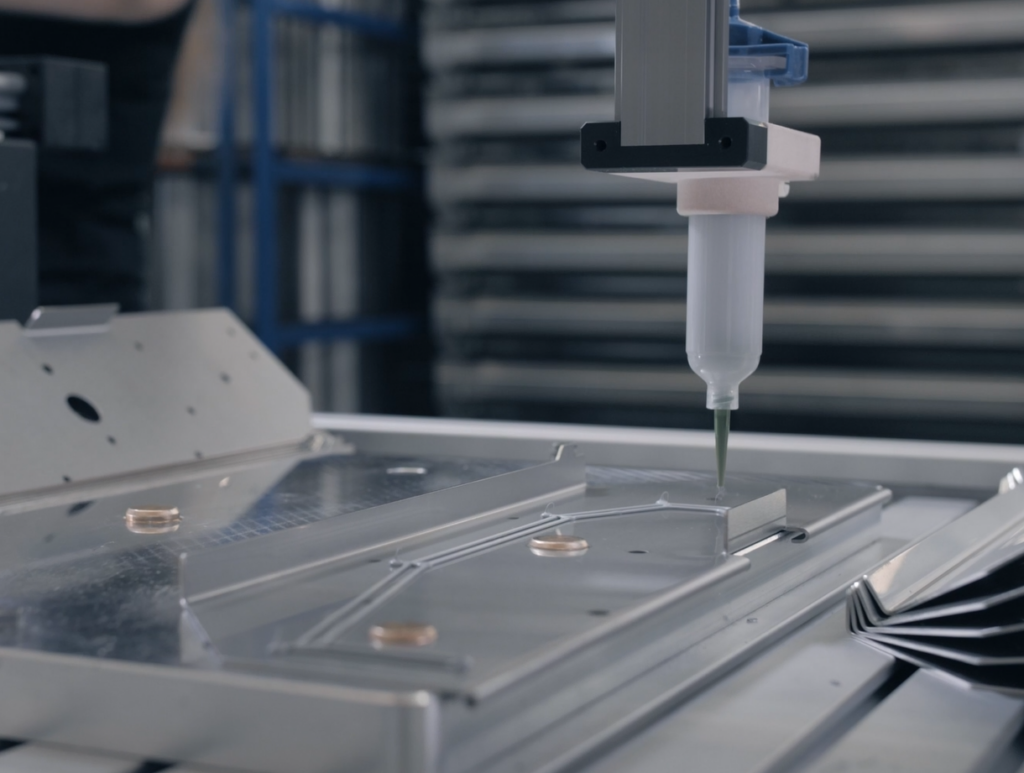
Für das Kleben und Dosieren lassen sich je nach Anwendung verschiedenste Robotersysteme einsetzen. Mithilfe eines eigenen Dosierroboter-Konfigurators können Anwender in nur wenigen Klicks eine individuelle Roboterlösung zusammenstellen, die präzise Klebe- und Dosiervorgänge automatisiert.
Wer noch nach Inspiration sucht, findet auf RBTX.com alle Anwendungsbeispiele aus der Praxis: https://rbtx.com/de-DE/solutions
RBTX ist eine eingetragene Marke der igus GmbH.
Das Kickstarter-Projekt „MD Robot Kit: Unlock your AI Robot Engineering Dream Job“ von MangDang zielt darauf ab, die Kreativität und das technische Know-how von Robotik-Enthusiasten zu fördern. Es bietet zwei Hauptroboter, die jeweils unterschiedliche Bedürfnisse und Interessen ansprechen.
Der erste Roboter, der Mini Pupper, ist in mehreren Versionen erhältlich, darunter Mini Pupper 1, Mini Pupper 2 sowie die Modelle 2G und 2GA. Dieser Roboter ist ein kostengünstiges, persönliches Quadruped-Kit, das mit Open-Source-Software ausgestattet ist. Der Mini Pupper unterstützt multimodale generative KI-Plattformen wie ChatGPT von OpenAI, Gemini von Google und Claude von AWS. Zudem ist er mit ROS1 und ROS2 kompatibel, was seine Fähigkeiten in den Bereichen SLAM (Simultaneous Localization and Mapping) und Navigation erweitert. Die Integration von OpenCV ermöglicht es dem Roboter, Deep Learning mit Kameras durchzuführen. Dank der Nutzung von Raspberry Pi und Arduino bietet der Mini Pupper eine hohe Anpassungsfähigkeit und Erweiterbarkeit, was ihn ideal für Entwickler macht, die ihre eigenen Projekte realisieren möchten.
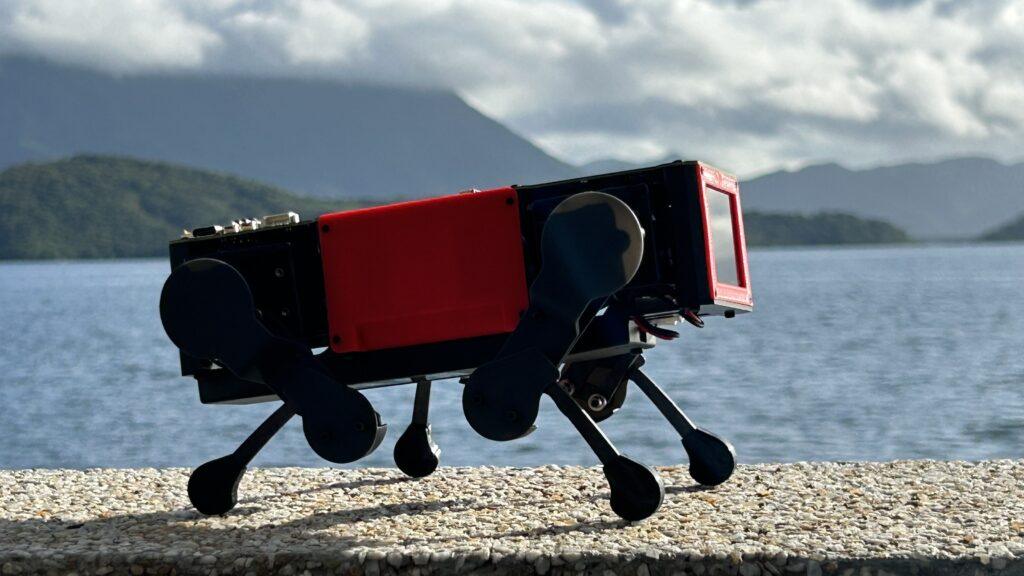
Der zweite vorgestellte Roboter ist der Turtle Robot, der bald verfügbar sein wird. Dieser Roboter richtet sich speziell an Schulen, Homeschooling-Familien und Roboter-Enthusiasten. Während detaillierte Spezifikationen noch nicht vollständig veröffentlicht wurden, ist klar, dass der Turtle Robot ebenfalls darauf abzielt, das Lernen und die Kreativität im Bereich der Robotik zu unterstützen.
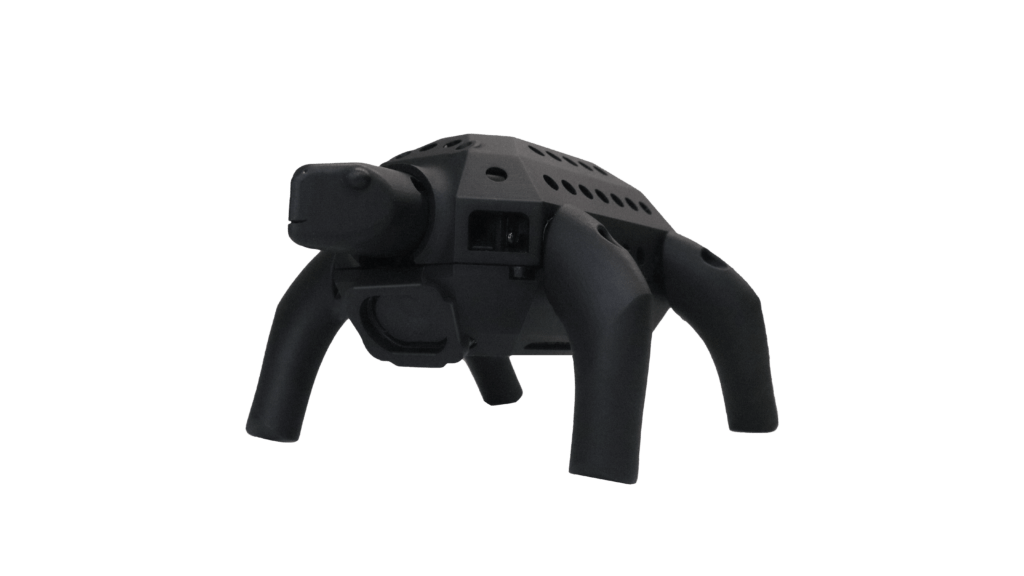
Die Kampagne selbst hat ein Finanzierungsziel von 9000€ gesetzt und dieses mit einer erreichten Summe von knapp 19000€ , was über 200% des ursprünglichen Ziels entspricht, deutlich übertroffen. Die Kampagne läuft vom 5. September 2024 bis zum 5. Oktober 2024 und zog bisher 80 Unterstützer an. Ein herausragendes Merkmal der MD Robot Kits ist ihre Open-Source-Natur, die es den Nutzern ermöglicht, die Roboter in weniger als einer Stunde zusammenzubauen. Dies macht sie besonders zugänglich für eine breite Zielgruppe, die von Bildungseinrichtungen bis hin zu DIY-Enthusiasten reicht. Das Projekt ist darauf ausgelegt, nicht nur technisches Wissen zu vermitteln, sondern auch die Freude an der Schaffung und Anpassung von Robotern zu fördern.

1. Mini Pupper:

2. Turtle Robot:

Seattle, WA – Crafted for portability, KT2 promotes physical activity through intuitive prompts and interactive games, making it a perfect companion for home and professional settings.
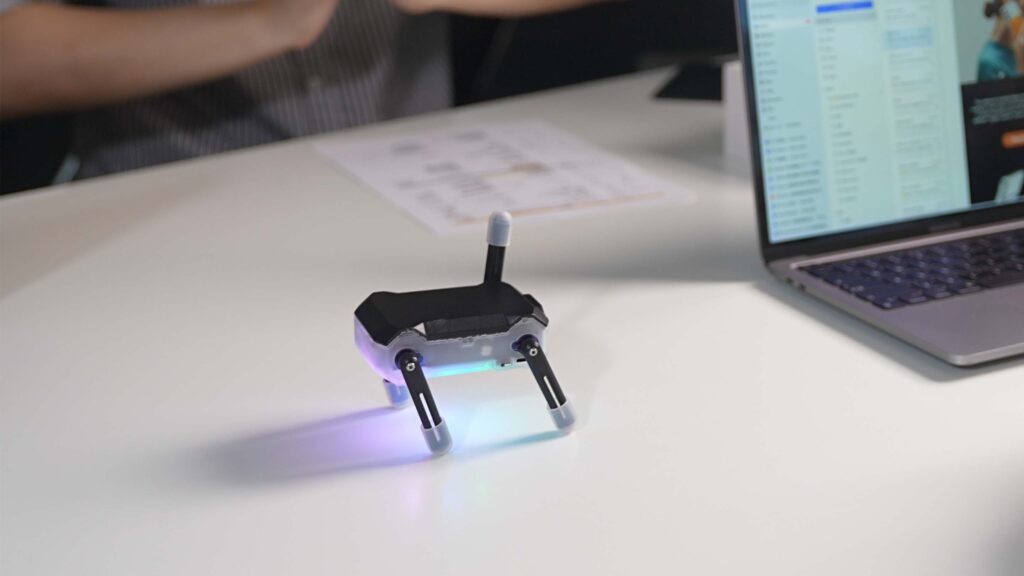
Designed by Seattle based tech company, Wair Living, the In-house robot innovation team KameRobotics have developed a mini-robot that enhances productivity at home, acts as a thoughtful companion, and is a diligent STEM teacher.
„Our KT2 robot prioritizes user privacy and minimalist with its design, featuring no integrated cameras or screen.“ said Qian Li, Founder of Wair and KameRobotics. „We want to ensure a secure interaction environment and more intuitive play via robot action and lighting interaction“.
KT2 Kungfu Turtle is not just a toy but a multifunctional companion for gaming, productivity, and learning. It features acrobatics, physical sparring, and autonomous return functions, supported by a powerful operating system and programmable chipset.
Beyond entertainment, KT2 enhances productivity in home and office environments. It includes a Pomodoro timer for focused work intervals and movement prompts to combat sedentary lifestyles. The modular design allows customization with accessories, transforming KT2 into a unique desk ornament and interactive companion.
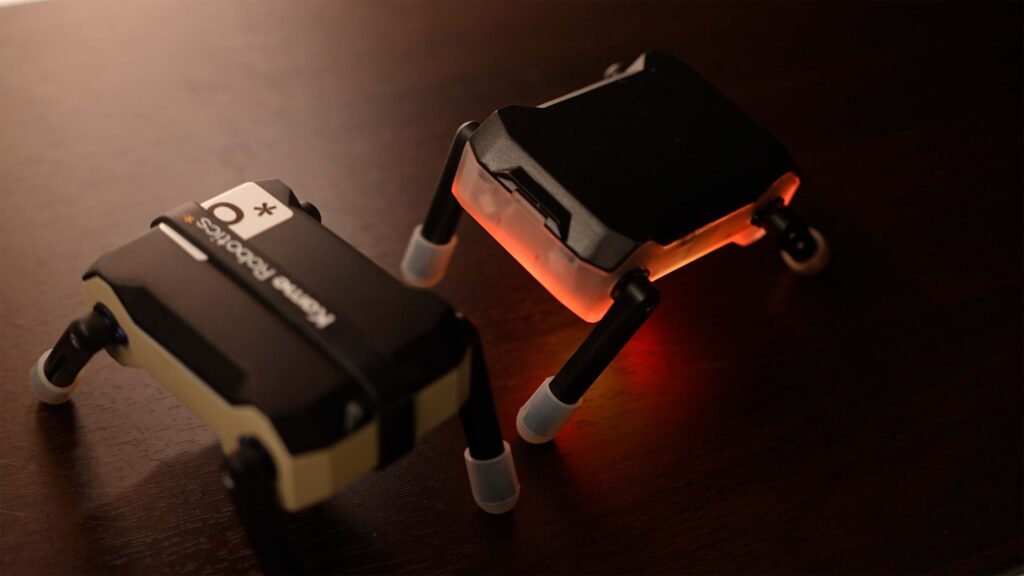
KT2 Kungfu Turtle is looking to raise $10,000 by 23rd August 2024. Early Bird rewards include a KT2 robot, access to 99 pre-installed games for $89, a significant discount from the $159 retail price. Shipping will be worldwide.
At the last Robotics Meetup Nuremberg, significant updates about the humanoid robot pib were announced: a new version is set to be released in August.
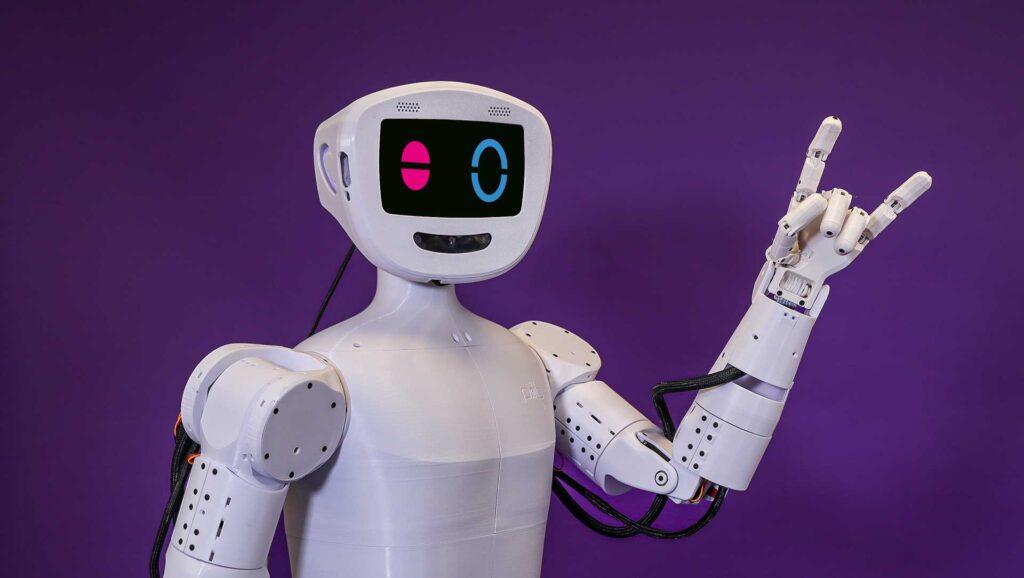
Changes from Last Year’s Version:
• Stylish Design: The upper body has been redesigned to be more stylish, with hidden screws and motors, and no loose cables.
• Easier Assembly: The new version offers simpler assembly.
• Enhanced Motors: The shoulders are now equipped with stronger motors.
• Improved Imitation Feature: Previously, pib could only follow horizontal movements. The updated version can also follow vertical movements.
• Upgraded Electronics: The electronics have been upgraded to a Raspberry Pi 5.
• Dockerization: pib is now dockerized, allowing installation on various software systems. This was a community effort, especially during the last hackathon.
• Digital Twin: A digital twin has been developed, enabling simulations and machine learning.
Continuity and Compatibility
Not everything has changed. The camera and display remain the same, and efforts have been made to maintain compatibility with the previous version. Updated tutorials are being prepared to ensure easy assembly.
The meetup also featured a guest speaker from EduArt Robotik, who introduced EduArt, the robot. After the presentations and discussions, everyone enjoyed pizza and drinks while networking with fellow robotics enthusiasts.
Miika K.I. ist ein innovativer Roboter und Experimentierkasten von Kosmos, der Kindern ab 10 Jahren einen spielerischen Zugang zu den Themen Robotik und künstliche Intelligenz ermöglicht. Dieser Roboter ist mit echter künstlicher Intelligenz ausgestattet, die von den Kindern selbst trainiert und gesteuert wird. So wird das Training einer künstlichen Intelligenz verständlich erklärt und nachvollzogen.
Miika K.I. kann durch Gesten oder Audiobefehle trainiert und gesteuert werden, ganz einfach mit einer App. Zur Nutzung der App, wird lediglich ein Smartphone oder Tablet benötigt. Um Miika K.I. für Kinder zwischen 10 und 14 Jahren zu einem sicheren Spielzeug zu machen, funktioniert die App rein lokal ohne Internet, sie speichert weder Bild- noch Audiodateien und leitet auch keine Daten an einen Server.
Beispielsweise kann Miika beigebracht werden, auf ein Schnipsen oder das Zeigen eines „Daumen hoch“ mit einer Drehung zu reagieren. Die Kreativität der Kinder sind beim Umgang mit Miikas künstlicher Intelligenz keine Grenzen gesetzt. Es lassen sich zwei Arten von KI trainieren; eine Version, die auf das Kamerabild des Smartphones oder Tablets reagiert oder eine Version, die auf wahrgenommene Geräusche reagiert.
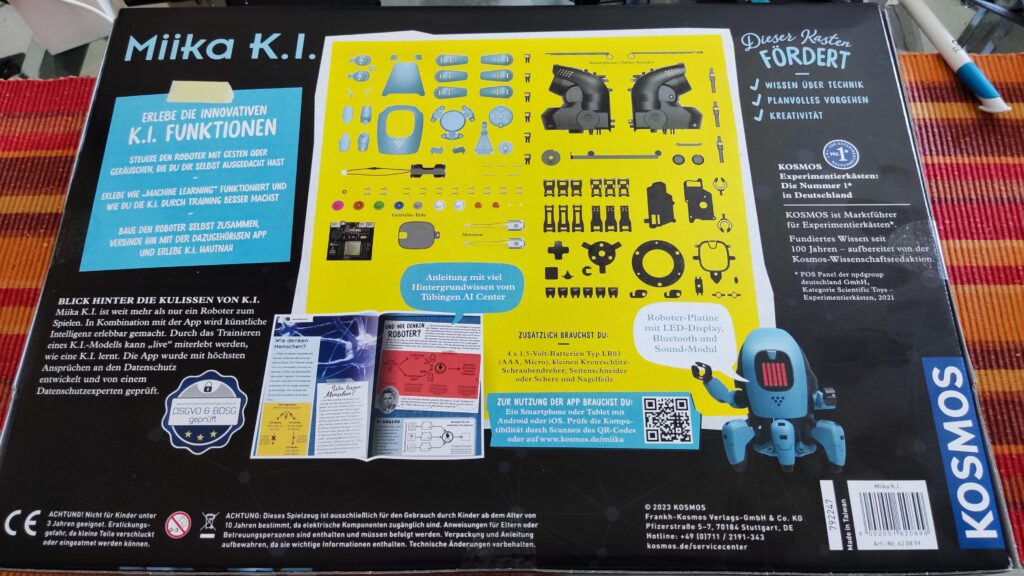
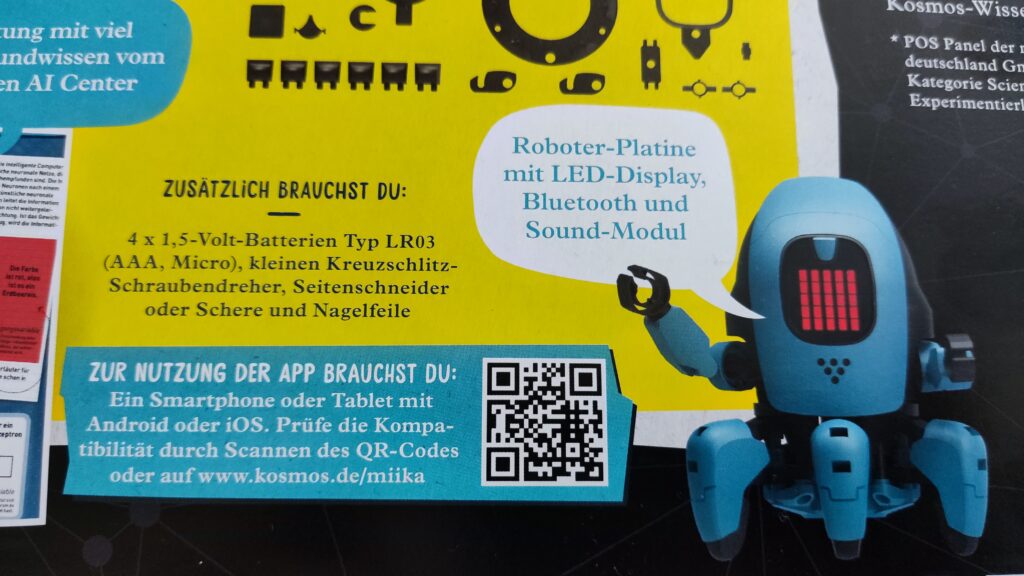
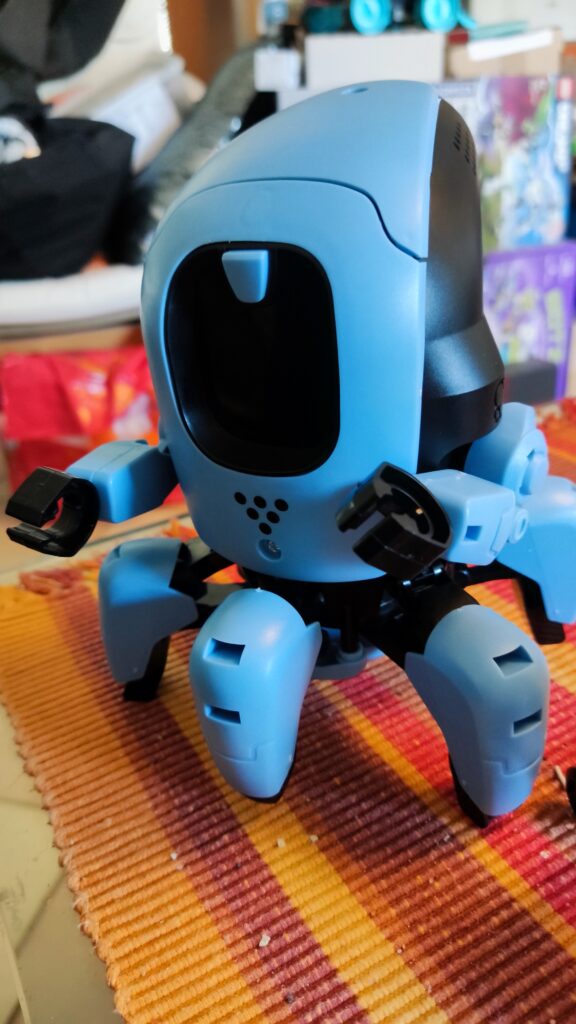
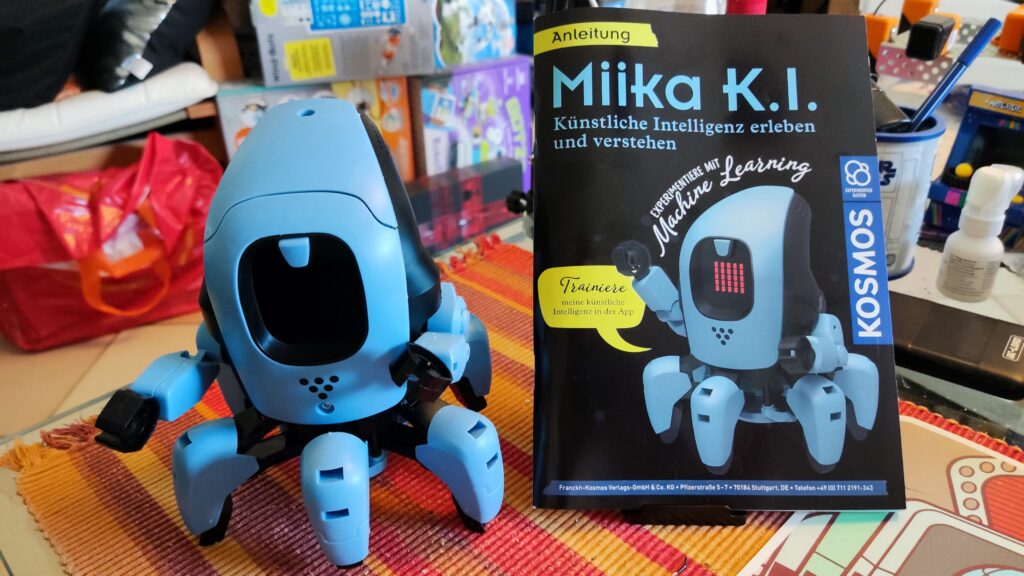
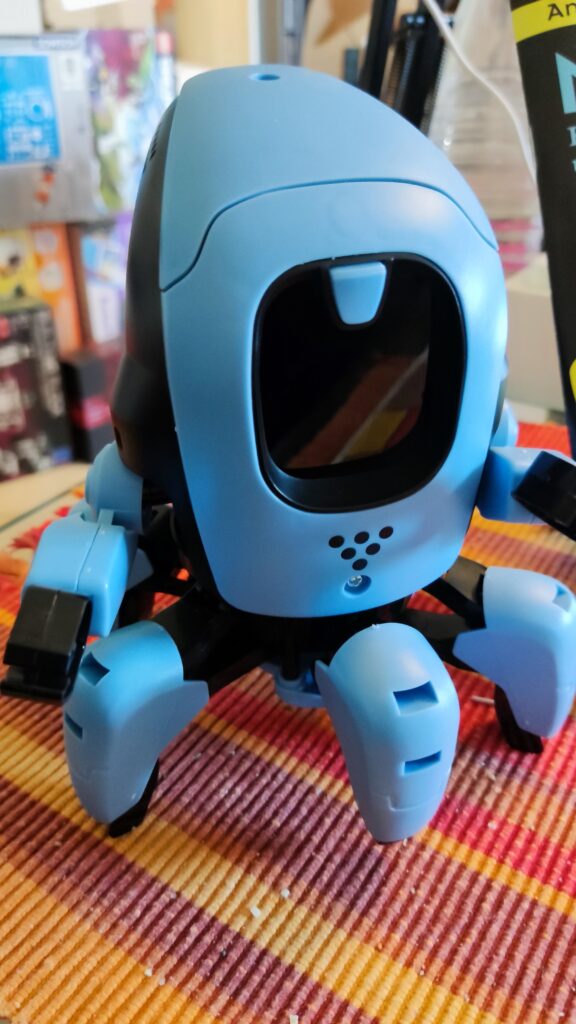
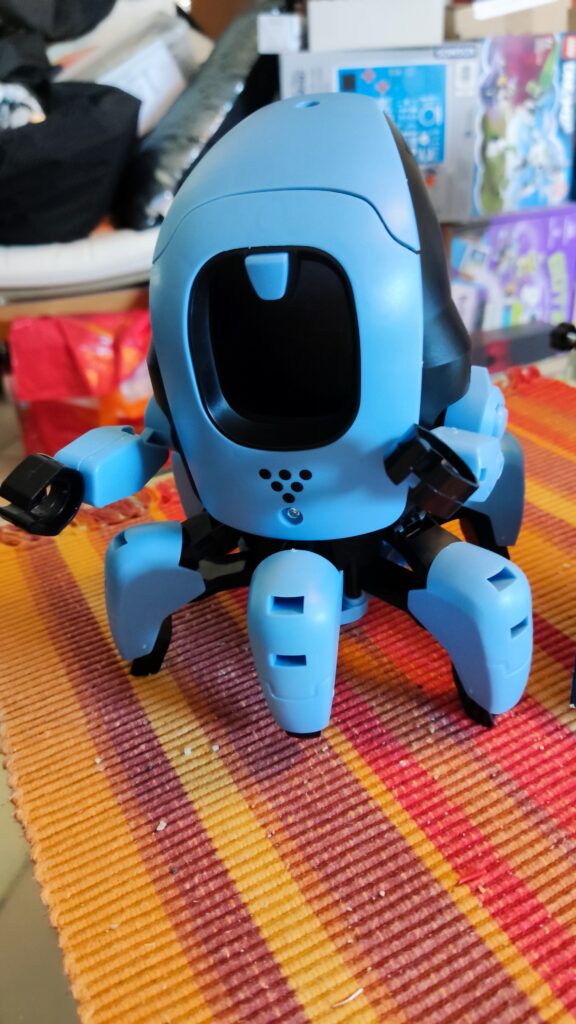
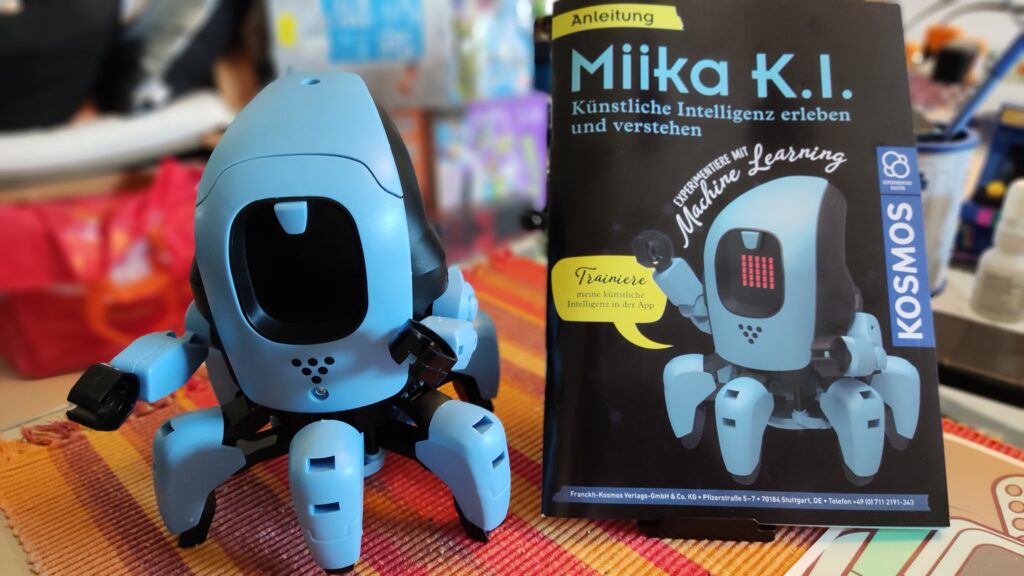
Der Roboter verfügt über ein LED-Display, auf dem Texte, Symbole und Gesichter dargestellt werden können. Miika kann sich bewegen, blinken und Töne von sich geben. Die Steuerung erfolgt über eine App, die offline arbeitet, um den Datenschutz zu gewährleisten.
Miika K.I. bietet den Kindern die Möglichkeit, die Technik der Zukunft spielerisch zu erleben und technologisches Verständnis zu vermitteln. Der Experimentierkasten wurde mit dem Toy Award 2023 ausgezeichnet.
Zum Lieferumfang gehören Bauteile zum Zusammenbau des Roboters, eine Bluetooth-fähige Platine mit LED-Display, zwei Motoren und eine Anleitung. Für den Betrieb werden vier 1,5-Volt-Batterien vom Typ LR03 (AAA, Micro) benötigt. Der Roboter hat die Abmessungen 425 x 265 x 79 mm und wiegt 766 Gramm.
Miika K.I. ist ein spannendes und lehrreiches Spielzeug, das Kindern die Möglichkeit bietet, die Möglichkeiten und Grenzen der künstlichen Intelligenz kennenzulernen und zu verstehen.